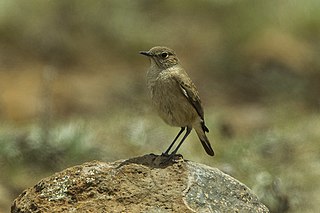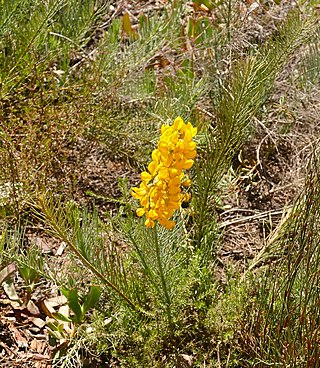
The Faboideae are a subfamily of the flowering plant family Fabaceae or Leguminosae. An acceptable alternative name for the subfamily is Papilionoideae, or Papilionaceae when this group of plants is treated as a family.

The genus Tylosema is in the plant family Fabaceae and encompasses four accepted species of perennial legumes native to southern and central Africa. These are semi-woody viniferous plants broadly distributed from Sudan and Ethiopia south to Angola and South Africa. Coetzer and Ross originally described four Tylosema species:

The sickle-winged chat or sicklewing chat is a small passerine bird of the Old World flycatcher family Muscicapidae endemic to southern Africa. It is a common resident breeder in South Africa and Lesotho, and is also found in southernmost areas of Botswana and Namibia. Its habitat is Karoo scrub, short grassland, and barren sandy or stony areas. In western coastal areas, it also occurs on agricultural land.

Lebeckia is a genus of plants in the family Fabaceae native to the fynbos of South Africa. Several members of Lebeckia were recently transferred to other genera. Members of Lebeckia are known to produce pyrrolizidine alkaloids, including ammodendrine, lebeckianine, and lupanine. The genus was named by Carl Thunberg for his student Heinrich Julius Lebeck.

Galegeae is a tribe in the flowering plant family Fabaceae, subfamily Faboideae. The tribe is found mostly in the northern hemisphere, but can also be found in Australia, Africa, and South America. Recent molecular phylogenetic work has determined that tribe Galegeae is paraphyletic, and that its members are scattered throughout the IR-lacking clade.

Crotalarieae is a tribe of flowering plants belonging to the family Fabaceae. It includes rooibos (Aspalathus linearis), harvested for sale as a tisane.

Argyrolobium is a genus of flowering plants in the family Fabaceae. It belongs to the subfamily Faboideae. Members of this genus are found in Africa and south Asia.

Hypocalyptus is a genus of flowering plants in the legume family, Fabaceae. It belongs to the subfamily Faboideae and is the only genus found in tribe Hypocalypteae.

Lessertia is a genus of flowering plants in the legume family, Fabaceae. The genus contains some 55 species and belongs to the subfamily Faboideae.

Otoptera is a genus of flowering plants in the legume family, Fabaceae. It belongs to the subfamily Faboideae. The generic name Otoptera is derived from a characteristic spur at the base of each wing petal and is a combination of the greek oto meaning ear and ptera meaning wing. Members of the Otoptera genus can be identified by the spur at the base of the petals and spoon shaped styles with two distinct lips.

Podalyria is a genus of flowering plants in the family Fabaceae. It belongs to the subfamily Faboideae. The genus is endemic to South Africa.

The tribe Podalyrieae is one of the subdivisions of the plant family Fabaceae.

Bauhinia petersiana, the Kalahari white bauhinia, is a species of shrubs from family Fabaceae found in Botswana, Zambia, Democratic Republic of Congo, Lesotho, Mozambique, Angola, Namibia, Tanzania, South Africa, and Zimbabwe. The species is 2 metres in height.

The inverted repeat-lacking clade(IRLC) is a monophyletic clade of the flowering plant subfamily Faboideae (or Papilionaceae). Faboideae includes the majority of agriculturally-cultivated legumes. The name of this clade is informal and is not assumed to have any particular taxonomic rank like the names authorized by the ICBN or the ICPN. The clade is characterized by the loss of one of the two 25-kb inverted repeats in the plastid genome that are found in most land plants. It is consistently resolved in molecular phylogenies. The clade is predicted to have diverged from the other legume lineages 39.0±2.4 million years ago (in the Eocene). It includes several large, temperate genera such as AstragalusL., HedysarumL., MedicagoL., OxytropisDC., SwainsonaSalisb., and TrifoliumL..

The Genistoids are one of the major radiations in the plant family Fabaceae. Members of this phylogenetic clade are primarily found in the Southern hemisphere. Some genera are pollinated by birds. The genistoid clade is consistently resolved as monophyletic in molecular phylogenetic analyses. It is estimated to have arisen 56.4 ± 0.2 million years ago. A node-based definition for the genistoids is: "the MRCA of Poecilanthe parviflora and Lupinus argenteus." One morphological synapomorphy has been tentatively identified: production of quinolizidine alkaloids. Some genera also accumulate pyrrolizidine. A new genus, to be segregated from Clathrotropis, has also been proposed to occupy an undetermined position within the genistoid clade.

Genisteae is a tribe of trees, shrubs and herbaceous plants in the subfamily Faboideae of the family Fabaceae. It includes a number of well-known plants including broom, lupine (lupin), gorse and laburnum.

The southern giraffe, also known as two-horned giraffe, is a species of giraffe native to Southern Africa. However, the IUCN currently recognizes only one species of giraffe with nine subspecies.

The Mirbelioids are an informal subdivision of the plant family Fabaceae that includes the former tribes Bossiaeeae and Mirbelieae. They are consistently recovered as a monophyletic clade in molecular phylogenies. The Mirbelioids arose 48.4 ± 1.3 million years ago. Members of this clade are mostly ericoid (sclerophyllous) shrubs with yellow and red flowers found in Australia, Tasmania, and Papua-New Guinea. The name of this clade is informal and is not assumed to have any particular taxonomic rank like the names authorized by the ICBN or the ICPN. Members of this clade exhibit unusual embryology compared to other legumes, either enlarged antipodal cells in the embryo sac or the production of multiple embryo sacs. There has been a shift from bee pollination to bird pollination several times in this clade. Mirbelioids produce quinolizidine alkaloids, but unlike most papilionoids, they do not produce isoflavones. Many of the Mirbelioids have pseudoraceme inflorescences.

Ben-Erik van Wyk FAAS is a South African professor of indigenous botany and traditional African medicine at the University of Johannesburg.


















